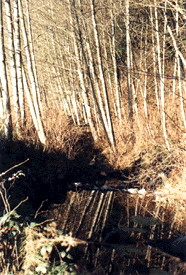Riparian Vegetation
For further information on undertaking a streamside planting project, please refer to Streamkeepers Handbook and Modules Module 7
 Stream banks need a good diversity of plant species to provide a variety of foods, cover types, and habitats for aquatic organisms, birds and wildlife. Both deciduous and coniferous species are important. Deciduous trees like black cottonwood grow rapidly and begin to enhance a stream quickly. Coniferous trees like red cedar grow more slowly, but will enhance a stream long after you and the cottonwoods have disappeared. A mixture of coniferous and deciduous plants ensures a year-round supply of leaf litter for a diverse community
of aquatic insects.
Stream banks need a good diversity of plant species to provide a variety of foods, cover types, and habitats for aquatic organisms, birds and wildlife. Both deciduous and coniferous species are important. Deciduous trees like black cottonwood grow rapidly and begin to enhance a stream quickly. Coniferous trees like red cedar grow more slowly, but will enhance a stream long after you and the cottonwoods have disappeared. A mixture of coniferous and deciduous plants ensures a year-round supply of leaf litter for a diverse community
of aquatic insects.
Native species common on British Columbia stream banks are listed below, along with habitat requirements and propagation methods. Each species has a definite preference for either wetland or upland conditions. For example, willows prefer wetter sites, whereas Douglas firs prefer drier soil.
| Codes: | ||
| COASTAL/INLAND | SUN/SHADE | WETLAND/UPLAND |
| c = coastal | s/ = sun | upl = obligate upland |
| i = inland | /s = shade | facu = upland/some wetland |
| ps = part shade | fac = upland + wetland | |
| facw = wetland/some upland | ||
| wet = obligate wetlands | ||
| Common Name (scientific name) | Coastal/
Inland |
Sun/
Shade |
Wetland/
Upland |
Propagation
Method |
| TALL CONIFEROUS TREES
Douglas fir (Pseudotsuga menziesii) Sitka spruce (Picea sitchensis) Western Hemlock (Tsuga heterophylla) Western Red Cedar (Thuja plicata) |
c/i c c/i c/i |
s/ps s/s /s /s |
upl fac facu fac |
seed, transplant seed, transplant transplant, seed transplant, seed |
| TALL DECIDUOUS TREES (>50 feet)
Big Leaf Maple (Acer macrophyllum) Black Cottonwood (Populus trichocarpa) Quaking Aspen (Populus tremuloides) Red Alder (Alnus rubra) |
c/i c/i i c |
s/ps s/ s/ s/s |
facu fac facw fac |
seed, transplant cutting, seed, transplant seed, sucker s>eed, cutting, sucker |
| SHORT DECIDUOUS TREES (15-60 feet)
Bitter Cherry (Prunus emarginata) Black Hawthorne (Crataegus douglasii) Cascara (Rhamnus purshiana) Crabapple ( Pacific) (Malus diversifolia) Mountain Alder (Alnus tenuifolia) Oso Berry/Indian Plum (Osmaronia cerasiformis) Red Elderberry (Sambucus racemosa v. arborescens) Vine Maple (Acer circinatum) Water or Black Birch (Betula occidentalis) White or Paper Birch (Betula papyrifera) Willows: Pacific (Salix lasiandra) Sitka (S. sitchensis) Scouler's (S. scouleriana) Sitka (S. sitchensis) (many called pussy willow) |
c c/i c/i c i c c c c/i c/i c/i |
s/ps s s/s s/ s/ s/s s/ps /s s/s s/ s/ |
facu fac fac fac facw upl facu facu wet facu facu/wet |
seed, transplant seed, transplant cutting, seed, transplant seed seed, transplant transplant, seed, cutting cutting, seed seed, transplant seed, transplant seed, transplant cuttings |
| SHRUBS (2-15 feet)
Blueberry, Huckleberry (Vaccinium spp.) Douglas, Rocky Mtn. maple (Acer Glabrum) Gooseberries (Ribes spp.) Hudson Bay currant (Ribes spp.) Mock Orange (Philadelphus gordonianus, P. lewsii) Ninebark (physocarpus capitatus) Nootka or Wild Rose (Rosa spp, R. nutkana) Red Osier Dogwood (Cornus stolonifera) Salal (Gaultheria shallon) Salmonberry (Rubus spectabilis) Service or Saskatoonberry (Amelanchier spp.) Sitka Alder (Alnus sinuata) Snowberry (Symphoricarpos albus) Snowbrush (Ceanothus velutinus) Spiraea or Hardhack (Spiraea douglasii) Tall Oregon Grape (Berberis aquifolium) Thimbleberry (Rubus parviflorus) Twinberry (black) (Lonicera involucrata) Twinberry (red) (Lonicera utahensis) |
c/i c/i c/i i c c c/i c/i c c c/i c/i c/i i c/i c/i c/i c/i i |
s/s /s s s s/s s/s s/ps s/s s/ s/s s/ s/s s/s s/ s/s s/s /s /s /s |
upl facu fac fac fac fac fac facw upl fac facu facw facu upl facw upl facu fac facu |
seed, cutting, sucker seed, transplant seed, cutting, layer seed, cutting, layer cutting, layer cutting cutting, sucker, seed cutting, seed, layer transplant, seed cutting, transplant sucker, seed seed, cutting, sucker cutting, transplant cutting, transplant sucker, transplant cutting, layer cutting, transplant cutting, seeds cutting, seeds |